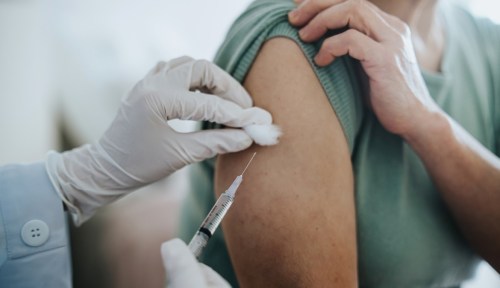You purchase period underwear because it’s touted as safe, healthy, organic, and eco-friendly. That’s all great until you learn that chemicals actually are in the product. The advertising terms that sold you now come across as dishonest, which may degrade your trust in your undergarments. So, what should you do when that time of the month comes? Is period underwear safe to wear?
Experts in This Article
medical toxicologist and co-medical director of the National Capital Poison Center
As a quick refresher, the period underwear manufacturer, Thinx Inc., recently settled a class action lawsuit that alleges Thinx’s marketing claims were misleading. Customers who bought the underwear within a certain window of time can submit for a refund or voucher from Thinx, but the company denies the allegations in the lawsuit and stressed that the settlement is not an admission of guilt or wrongdoing.
With all of that going on, we talked with Kelly Johnson-Arbor, MD, FACEP, FUHM, FACMT, a medical toxicologist and co-medical director of the National Capital Poison Center in Washington, DC, to find out what these concerning chemicals are, the health risks they pose, and how worried we should all be about our period underwear.
So, what chemicals are in period underwear?
Chemicals have been found in other brands of period underwear, as well, and some of the companies also use similar language, such as, “natural,” “non-toxic,” or “sustainable,” to describe their products. Confusion about the safety of period underwear has to do with per- and poly-fluoroalkyl substances (PFAS) also called “forever chemicals” being detected in the material. PFAS are manmade materials that are used to make coatings and products that resist stains, grease, heat, oil, and water. They’re in clothing, furniture, adhesives, and non-stick cooking surfaces, according to the Centers for Disease Control and Prevention (CDC).
“PFAS are used in takeout containers, stain-resistant fabrics, and cosmetics. The chemical composition of PFAS compounds includes fluorine and carbon atoms that are bonded together and are very resistant to breakdown,” says Dr. Johnson-Arbor.
Not only do PFAS hang around in the environment, pretty much forever, but they also build up in fish and wildlife and can move through soils and contaminate drinking water sources.
What are the health risks of PFAS?
People are exposed to PFAS by consuming contaminated food or water, according to the CDC, and possibly by using products that contain PFAS. Health risks from exposure to low environmental levels are uncertain, but studies of laboratory animals given large amounts of PFAS show that growth and development may be affected. PFAS may also affect the immune system, reproductive health, thyroid function, and the liver.
PFAS exposure has also been associated with cancer. “Many people understandably want to avoid excessive PFAS exposure, including from PFAS found in period underwear,” Dr. Johnson-Arbor says. “While there is no evidence that PFAS found in period underwear are directly responsible for any undesirable health conditions, the additive effects of PFAS exposures from multiple different sources may be dangerous for our health overall.”
Of course, animal studies aren’t the same as human ones, so it can be difficult to make a connection between the results of animal studies and human health outcomes. “For PFAS, even some of the human studies have been inconclusive,” Dr. Johnson-Arbor says. “Since almost 100 percent of people living in developed countries have detectable levels of PFAS in their bloodstreams, it is challenging to determine exactly what adverse health effects are attributable to PFAS and not another chemical or environmental exposure.”
How do I know if my period underwear is safe from PFAS?
Period products are regulated by the U.S. Food and Drug Administration (FDA). Though depending on a product’s classification, the manufacturers may not include all the materials used. You still want to review the product labels and the manufacturer’s website to see what else you can learn about the ingredients involved.
“Products that are advertised as being waterproof (a quality that is highly desirable in period underwear) are likely to contain PFAS or similar substances. Even if a specific product is certified as being PFAS-free, these chemicals could still be unintentionally introduced into the underwear through the manufacturing or packaging process, given that PFAS are found so widely throughout the environment.” Dr. Johnson-Arbor says. “It’s important to remember that PFAS are everywhere and nearly impossible to avoid in our daily lives. We don’t fully understand all the potential health effects of PFAS.”
A concern with PFAS and period products is that the vaginal area is highly sensitive and can be absorbent. “There is no evidence connecting PFAS exposure in period underwear to any adverse health effects, and from a medical toxicology perspective it’s safe to wear period underwear because of this,” Dr. Johnson-Arbor says. “Period underwear should be washed between uses and some manufacturers even recommend washing the underwear before its initial use. It’s possible that the washing process will decrease the PFAS content, making absorption even less likely.”
The class action complaint also alleges that Thinx underwear contains metal nanoparticles used to deodorize clothing and can easily enter the body. Nanoparticles are small particles that can be composed of different substances including carbon, polymers, or metals, and are used in daily items like toothpaste and cosmetics. “Metal-based nanoparticles are also used in medicine due to their antimicrobial activities and are also added to toys and fabrics for this same purpose,” Dr. Johnson-Arbor says. “There are no diseases that are conclusively linked to metal nanoparticle exposure. However, because they are so small, nanoparticles can enter the body and potentially cause DNA damage, hormonal imbalance, and immune system dysfunction.”
There may not be enough evidence to support that period underwear is unsafe, but is there enough data to show that it’s not? Until there are further studies or regulations, it may come down to personal choice, and whatever brings you peace of mind.
Sign Up for Our Daily Newsletter
Get all the latest in wellness, trends, food, fitness, beauty, and more delivered right to your inbox.
Got it, you've been added to our email list.











